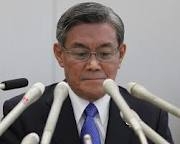
Kansai Electric submits safety upgrade plans
Kansai Electric Power sought government approval to restart two nuclear reactors while key upgrades to prevent nuclear crisis will take three years.
The Japanese utility submitted its safety plans for two reactors at the Ohi plant in Fukui prefecture, and the government's final decision on whether to restart the reactors is reportedly expected later this week.
"We'll aim to achieve the world's top-class safety at our plants," said Kansai Electric President Makoto Yagi as he handed the safety improvement roadmap to Economy and Industry Minister Yukio Edano.
However, more than one third of the necessary upgrades on the list are still incomplete.
Filtered vents that could substantially reduce radiation leaks in case of an accident threatening an explosion, a radiation-free crisis management building, and fences to block debris washed up by a tsunami won't be ready until 2015. This means the plant, as well as plant workers and residents, won't be fully protected from radiation leaks if a Fukushima-level accident occurs while the measures are being taken.
The startup guidelines are based on recommendations adopted last month by the Nuclear and Industrial Safety Agency. The most crucial measures to secure cooling functions and prevent meltdowns as in Fukushima were incorporated in the government's guidelines, but the rest were not.
Some experts said a resumption without these key protections would leave the plant vulnerable.
Tadahiro Katsuta, a Meiji University associate professor who was on a government panel that produced nuclear safety recommendations, said the upgrades completed are "mostly quick-fix measures," and that more important ones, such as a crisis management center, have been put off.
"The operators are expected to take initiative to improve safety and reliability, and never dwell on the safety myth," Edano told Yagi, urging the utility to expedite the process.
Ohi town mayor Shinobu Tokioka called the roadmap a "step forward," but urged the central government and nuclear regulators to carefully review the reactors' safety.
For more, click here.























 Advertise
Advertise







